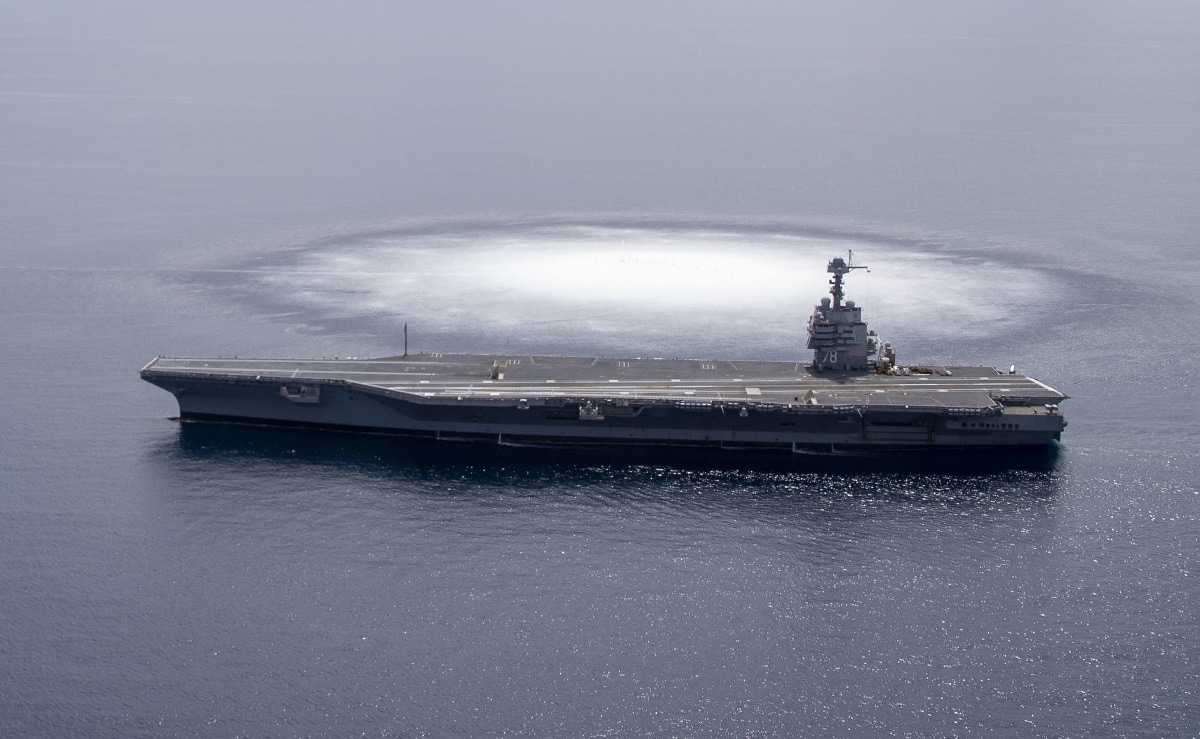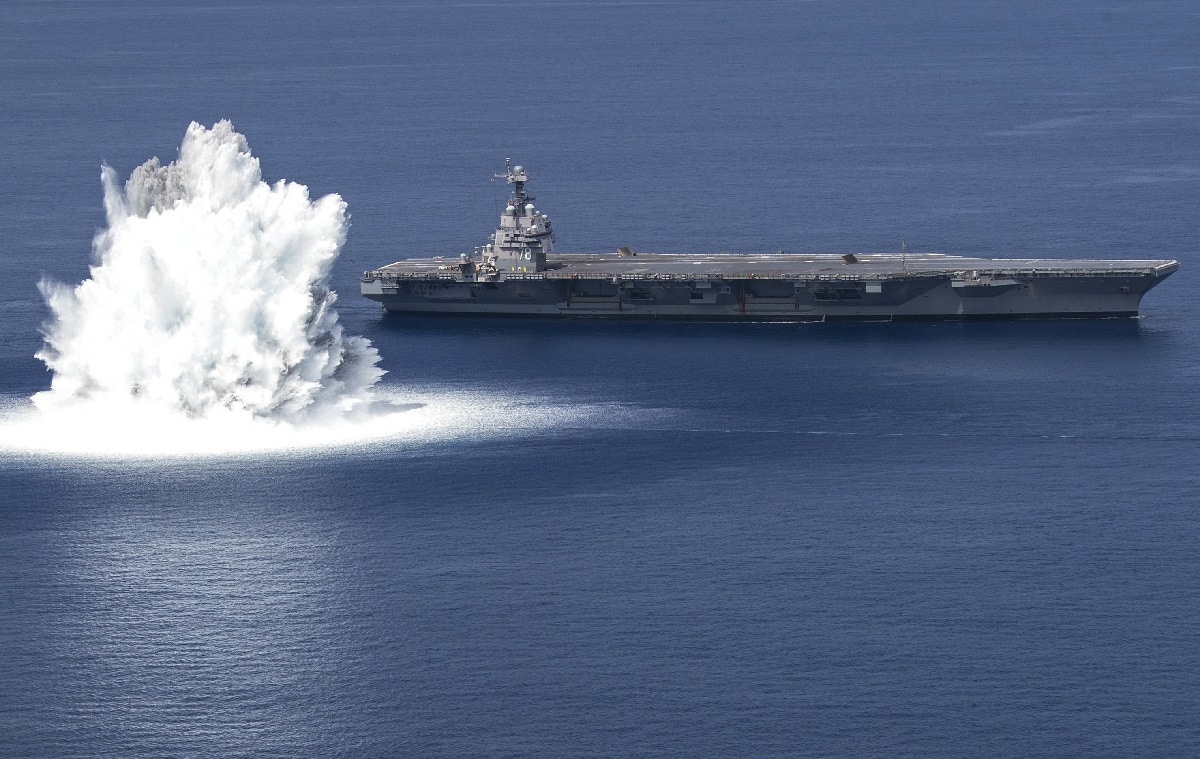This past weekend, the United States Navy’s newest aircraft carrier, USS Gerald R. Ford (CVN-78), concluded its full ship shock trial (FSST) testing after the service detonated the third and last explosive charge near the ship’s hull off the coast of Florida. In the latest shock trials, it involved detonating some 40,000 pounds of ordnance in the water near the hull, as a way to test the ship and its systems.
Putting a brand new warship – the most expensive one at that – through such tests was done to ensure it could survive a near miss from an enemy combatant. The ship passed the final FSST as expected, with no major injuries, no fires, and most notably no flooding. Helicopters were even able to land on the deck of the flat top within minutes of the controlled detonation, while other assets were also able to move around the deck as well.
“We had zero catastrophic failures on the ship, zero situations where we had flooding or anything, and zero fires,” Capt. Paul Lanzilotta, Ford’s commanding officer, told reporters in a call on Monday, according to USNI News. “All that is pretty significant.”
USS Gerald R. Ford had finished her post-delivery test and trails (PDT&T) phase earlier this year, prior to the first of her three shock trial tests that began in June.
Shocks on a Super Carriers
The rattling of the carrier from the initial blast, followed by the aftershocks, lasted for about ten to fifteen seconds. Sailors onboard the carrier described the feeling as being similar to a percussion hit; not as intense as a car accident, but still strong enough that they were quite shaken by it.
Few carrier sailors, who essentially live in a floating city, would likely ever experience such an intense episode apart from a drill. At nearly 1,100 feet in length, supercarriers can easily cut through most seas with minimal rolling, while the ship is so large that it typically takes turns slowly. Moreover, courses are set to minimize the ship’s pitch and roll – as any abrupt or extreme movement can result in damage to its aircraft while it can put the crew in harm’s way. That isn’t to say that carriers can’t handle rough water, but major storms are typically avoided.
Despite being shaken around by the blast, the crewmembers handled it accordingly. Most were at their respective battle stations for an hour before the explosive charges were detonated, and while the actual shock test has been described as a brief sensation of “shock and awe,” the sailors quickly snapped back to their training. Most were actually surprised by the limited impact the tests had on the carrier.
Minor Damage
Capt. Lanzilotta didn’t provide a list of what actually broke during Sunday’s test, but he told reporters that the team prearranged to make any necessary fixes during CVN-78’s scheduled, planned incremental availability (PIA), which will be completed before the carrier’s expected deployment next year.
“I definitely know that we have added items to our planned incremental availability, however, we actually planned for that,” Lanzilotta added. “And nothing that I’ve seen reported to me so far is in the category of so much more work than I expect it to add to the scope of the availability in terms of schedule.”
The shock trials provide data used in validating the shock hardness of the warship.
The origin of an FSST dates back to the Second World War, and the U.S. Navy has conducted tests over several decades, most recently for the Littoral Combat Ships USS Jackson (LCS 6) and USS Milwaukee (LCS 5) in 2016; as well as for the San Antonio-class amphibious transport dock USS Mesa Verde (LPD 19) in 2008, the amphibious assault ship USS Wasp (LHD 1) in 1990, and the guided missile cruiser USS Mobile Bay (CG 53) in 1987.

The aircraft carrier USS Gerald R. Ford (CVN 78) completes the first scheduled explosive event of Full Ship Shock Trials while underway in the Atlantic Ocean, June 18, 2021. The U.S. Navy conducts shock trials of new ship designs using live explosives to confirm that our warships can continue to meet demanding mission requirements under harsh conditions they might encounter in battle. (U.S. Navy photo by Mass Communication Specialist 3rd Class Riley B. McDowell)

The aircraft carrier USS Gerald R. Ford (CVN 78) completes the first scheduled explosive event of Full Ship Shock Trials while underway in the Atlantic Ocean, June 18, 2021. The U.S. Navy conducts shock trials of new ship designs using live explosives to confirm that our warships can continue to meet demanding mission requirements under harsh conditions they might encounter in battle.
According to the Navy, the last aircraft carrier to execute FSST was USS Theodore Roosevelt (CVN 71) in 1987.
As President Gerald Ford was known to be a competitive athlete, who even played college football for the University of Michigan, no doubt he’d be impressed that the warship bearing his name can ensure such a serious test and come off with minimal damage.
Peter Suciu is a Michigan-based writer who has contributed to more than four dozen magazines, newspapers and websites. He regularly writes about military small arms, and is the author of several books on military headgear including A Gallery of Military Headdress, which is available on Amazon.com.

